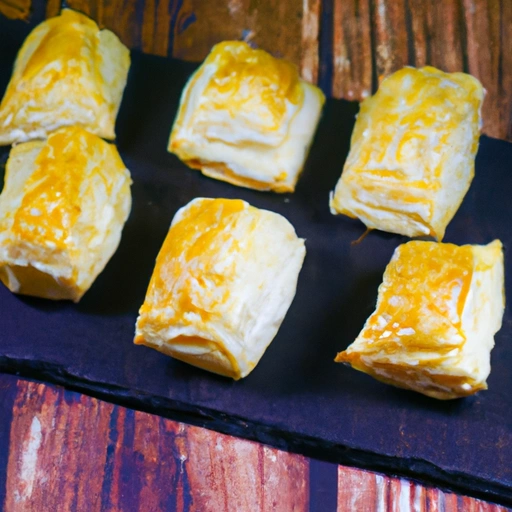Puff Pastry
Description

Puff pastry, also known as pâte feuilletée, is a light, flaky, and buttery dough that is widely used in both sweet and savory dishes. The unique property of puff pastry comes from its multiple layers, which are achieved by folding the dough multiple times, creating hundreds of paper-thin layers of dough separated by butter. When baked, the moisture in the butter creates steam, causing the dough layers to rise and separate, resulting in a puffy, airy texture.
Common uses
Puff pastry is commonly used to create a variety of pastries and dishes, including pies, tarts, vol-au-vents, pasties, turnovers, and more. It serves as a base for numerous desserts, such as Napoleons, cream horns, and palmiers. Its ability to puff up and turn golden brown when baked makes it an attractive and delicious component in both classic and contemporary recipes.
Nutritional value
Calories
Typically, one sheet of puff pastry (about 1 oz or 28 grams) contains approximately 150-160 calories.
Protein
Puff pastry generally has about 2-3 grams of protein per sheet.
Fat
Puff pastry is high in fat, with around 10 grams per sheet, most of which is saturated fat due to the butter content.
Carbohydrates
It contains approximately 15 grams of carbohydrates per sheet.
Vitamins
Puff pastry is not a significant source of vitamins; however, it may contain small amounts of B vitamins, depending on the flour used.
Minerals
Depending on the ingredients, puff pastry may contain trace amounts of minerals such as iron and calcium.
Health benefits
As puff pastry is high in fats and carbohydrates, it is generally considered a treat rather than a health food. However, when consumed in moderation, it can be part of a balanced diet.
Potential risks
Due to its high butter content, puff pastry is high in saturated fats, which should be consumed in limited quantities. Overconsumption may increase the risk of heart disease and other health issues.
Common recipes
Puff pastry is used in a multitude of recipes ranging from sweet to savory, including tarts, quiches, croissants, turnovers, and Beef Wellington.
Cooking methods
The typical method of cooking puff pastry is baking it in an oven preheated to about 400°F (205°C) until it puffs up and turns golden brown.
Pairing with other ingredients
Puff pastry pairs well with various fillings such as fruits, custards, cheeses, meats, and vegetables.
Summary
Puff pastry is a versatile ingredient beloved by chefs and home cooks around the world for its flaky, buttery layers. Its historical roots in France and its spread to the rest of Europe and America showcase its timeless appeal. While it’s not the healthiest option due to its high fat content, it remains a popular choice for special occasion dishes and desserts. Understanding its nutritional profile and potential risks can help individuals enjoy puff pastry while maintaining a balanced diet.